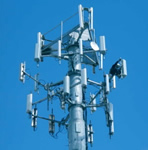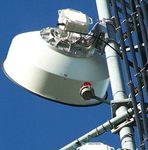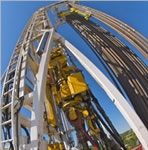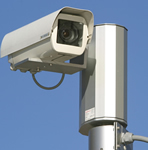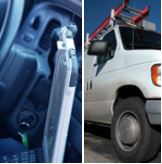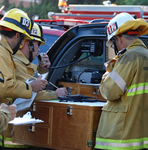 |
Simple Omni-Directional Antenna Connected to USB Modem
Also includes a Cellular 3G router and lightning protection. Note that coaxial cable run from roof to modem is 75ft so need high quality (low-loss) cable such as the LMR-400 cable shown but even with this the attenuation is 4.4dB. Therefore need a powerful antenna such as the 9dBi shown to make up for the cable losses. Preferably a higher-gain directional Yagi antenna should be used instead but will require orientation to directional of maximum received signal strength.
|
|

|
Cellular direct-connect In-Building Amplifier, outdoor Omni-directional antenna
|
Improve in-building cellular coverage. System includes:
|
An outdoor antenna is Omni-directional:
|
Useful when you don't know the direction of maximum received signal strength or don't want to orient outdoor antenna. Receives signal from all directions. |
Outdoor antenna is also dual-band: |
work with both 800 & 1900MHz cellular systems. |
| An amplifier is direct-connect: |
Directly attaches to 3G/4G data modem for maximum power transfer |
| Includes WWAN router (optional) |
Converts cellular 3G/4G data to WiFi/LAN |
|

|
Cellular direct-connect In-Building Amplifier, outdoor directional yagi antenna
|
Improve in-building cellular coverage. System includes:
|
An outdoor antenna is directional: |
provides high antenna gain. Need to orient to the direction of maximum received signal strength. |
Amplifier/Router/surge protection similar to the case above with Omni-directional antenna |
| Special case for Option Globesurfer III Fixed wireless Terminal |
| Special case for Axesstel MV400-Series Gateway. For other Axesstel modems and gateways see /Signal_Improvement/Axesstel |
|

|
Cellular wireless In-Building Amplifier, outdoor Omni-directional antenna
|
|
Improve in-building cellular coverage. System includes:
|
|
The outdoor antenna is Omni-directional: |
Useful when you don't know the direction of maximum received signal strength or don't want to orient outdoor antenna. Receives signal from all directions. |
Outdoor antenna is also dual-band: |
work with both 800 & 1900MHz cellular systems. |
| Work with both 800 & 1900MHz cellular systems. |
the amplifier doesn't physically attach to the modem. Allows using a single amplifier with multiple 3G/4G phones/modems in the same room. |
| Includes WWAN router (optional) |
Converts cellular 3G/4G data to WiFi/LAN |
|

|
Cellular wireless In-Building Amplifier, outdoor directional antenna
|
Improve in-building cellular coverage. System includes:
|
The outdoor antenna is directional: |
provides high antenna gain. Need to orient to the direction of maximum received signal strength. |
Amplifier/Router/surge protection similar to the case above with Omni-directional antenna |

|
Special case for Option Globesurfer III Fixed wireless Terminal |
|

|
High Gain Yagi Antenna for Option Globesufer III
(Generic for any radio. Just change the antenna pigtail depending on your device antenna port.)
|
|

|
High Gain Directional / Yagi Antenna Kit for Cellular Devices
(Generic for cellular device including 4G LTE Modems / Gateways, Mobile Hotspots, Wireless Routers, Wireless Home/office phones and other . Just change the antenna pigtail.)
|
 |
1900MHz In-Building Solution for Extremely Low RSS & Wide Area Coverage
This is specifically where we need to cover a large room and the outdoor signal is very weak. This is specific for 1900MHz (hint Sprint PCS uses only 1900MHz but for other carriers need to figure out from their tech support or from the mobile device what frequency is in use). Note that if your outdoor signal is very strong you would need to use an appropriate attenuator to avoid saturating the high-gain amplifier/ repeater
|
 |
1900MHz In-Building Solution for Multiple Rooms
Similar to above but in this case we need the boosted cellular signal to cover multiple rooms. In this case, the distance to the room is close enough such that the losses through the coaxial cable and the -3dB loss through the splitter doesn't take the signal below the noise floor. For more splitters/combiners or diplexers see Radio Passives
|
| WiMAX DRAWINGS |
|

|
Generic WiMax USB Modem Dual Antenna Configuration (for 4G ONLY)
Pigtail options for Sierra Wireless 250U & Ubee PXU1900 (Clear 4G USB modem)
|
 |
Simplified Construction Drawing for Portable Cellular 3G & WiMax 4G Internet Solution
Example of what is needed to place a Cellular/WiMax/WiFi router in a pelican case and drill through-holes for multiband Cellular/PCS/WiMax antenna and WiFi antenna including pigtails, cables, and connectors. We show solution using Sierra 250U modem available from Clear/Sprint but could be extended to any 3G, 4G or Dual 3G/4G modem. Contact us for alternates or variations.
|
|

|
Remote Mobile Communication Solution #2
A generic example of a communication trailer for example for emergency management. Shown here with the aggregation of 5 cellular 3G and WiMax 4G data modems for increased performance and redundancy. Design includes:
- [Page1] Isolation of 3G Cellular & 4G WiMax RF paths with cross-band coupler/ diplexer for independent boosting (and to prevent filtering out of higher frequency Wimax band by 3G cellular bi-directional amplifiers).
- [Page2] Splitting 2.4GHz WiFi RF path into two channels one goes to outdoor MIMO antennas and other go-to indoor antennas.
Shown for vehicle use but easily adapted to the building, remote sites, etc. Contact us for the entire solution and for your custom design based on specific constraints and target specifications.
|
 |
WiMax Antenna Solutions for Digital Signage and Remote Kiosk Internet
Different topologies are shown for hooking up a remote dynamic messaging system or remote kiosk internet. Techniques are equally applicable for 4G LTE systems using equivalent LTE antennas (or multiband antennas to enable both 3G & 4G data).
|
|

|
1900MHz 3G Cellular & 2.5-2.7GHz 4G WiMax In-Building Solution (uses diplexer to re-use same coaxial transmission cabling)
To improve indoor coverage of dual 4G systems. We use a high-gain directional cellular band antenna (1.9GHz PCS) and a high-gain directional WiMax antenna (2.6GHz). We pass the cellular signal through an RF bidirectional amplifier (BDA) and combine it with the WiMax signal using a low-loss 2-way diplexer. We then couple the signal to the 4G modem. Contact us if interested in using MIMO diversity as well or see the forums.
|
 |
High Gain Directional Antenna for WiMax 4G Modem
(for Xohm/Clearwire Zyxel Modem)
|
|

|
Clear 4G USB Modem (PXU1900) Outdoor Omni-Directional Antenna
Improving In-Building coverage for the Clear 4G USB Modem (PXU1900) using outdoor Omni-directional antennas (2 antennas used for full MIMO support).
|
 |
Clear 4G USB Modem (PXU1900) Outdoor Directional Antenna
Improving In-Building coverage for the Clear 4G USB Modem (PXU1900) using outdoor directional panel antennas (2 antennas used for full MIMO support).
|
 |
WiMax MIMO External Antennas (Omni-Directional + Directional Panel)
Shown in this drawing to include a Peplink MultiWAN router which combines multiple WiMax, Cellular or other ISP Internet connections for increased bandwidth. For example, if you have multiple LAN clients that need to concurrently upload or download data using a WiMax connection, you may combine multiple WiMax connections to improved average speed per client or for redundancy/failover.
|
|

|
Cellular and Wi-Fi Signal Improvement with a Multi-WAN Router
The drawing shows improvement of cellular signal using a directional antenna. This requires that the antenna be oriented to the direction of maximum received signal strength. You can use Omni-directional antennas for situations where signal reception is not specific. Solution also includes a Wi-Fi signal improvement solution with a dome antenna.
|
